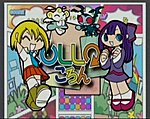The basics of the game are, well, basic. However it's when you play against another person or a CPU-controlled character that the real fun begins. When you eliminate blocks you initiate an attack on your opponent, the more blocks you remove, the larger or more potent the attack. The type of attack that is unleashed depends on the colour of blocks you have just removed. Destroy red blocks and your opponent has to deal with larger rotating groups, making fine control of block placement more difficult. Remove purple blocks and some of your opponent's blocks will become stuck together, forming larger, awkwardly-shaped blocks that will only count as one when trying to join four together. Other attacks involve covering up some of the screen, hiding the colours of blocks under the rotation cursor, inverting controls and dropping huge blocks in to the top of your opponent's play area. On the other hand, not destroying enough blocks will cause neutral blocks to be dropped into your opponent's play field. The blocks re-colour themselves to match any disappearing blocks that they touch, thus bumping up the number of blocks destroyed and creating more powerful attacks for your opponent.
The presentation of the game deserves some mention. The basic style is best described as "so anime it hurts", fans of Doki Doki School Hours will love the look of this game. Everything from the avatar characters to the blocks themselves look ripped from the pages of a cute manga comic or cartoon. This style is continued in the menus which are presented as individual cells from a comic, complete with speech bubbles. There is even a page-turning effect shown when you move to another screen. The overall effect is a very distinct style which is so far removed from the current "realistic" trend in graphics and presentation that the effect is quite jarring at first. Each of the avatars has their own set of animations when playing, winning and losing, but you shouldn't be looking at them if you want to keep up with the game.
The different modes don't seem to change much in the way that you play the game except the ad-hoc link up game that enables you to play against another human. Disappointingly, that other human will also have to own a copy of the game since there are no game sharing options in Koloomn. Neither do the different characters' apparently different play styles seem to make much difference to the games you play against them.
Ultimately, Koloomn is addictive, but empty. There is no sense of progression even when defeating one opponent and moving on to the next, since each game is so like the last. The play area is small, which gives you a hemmed-in feeling and leaves little room to manoeuvre. The pace of the game picks up very quickly too, leaving you feeling like you have little control over events after only a few extra rows of blocks have been inserted into the play field.
SPOnG rating: C+
Genuinely new block-busting puzzle games are few and far between. Koloomn looks like a new game, but is really just a twist on several older ones that is presented in a fresh new way. It has the addictive "one more go" quality, but eventually disappoints with the lack of progress possible.
The presentation of the game deserves some mention. The basic style is best described as "so anime it hurts", fans of Doki Doki School Hours will love the look of this game. Everything from the avatar characters to the blocks themselves look ripped from the pages of a cute manga comic or cartoon. This style is continued in the menus which are presented as individual cells from a comic, complete with speech bubbles. There is even a page-turning effect shown when you move to another screen. The overall effect is a very distinct style which is so far removed from the current "realistic" trend in graphics and presentation that the effect is quite jarring at first. Each of the avatars has their own set of animations when playing, winning and losing, but you shouldn't be looking at them if you want to keep up with the game.
The different modes don't seem to change much in the way that you play the game except the ad-hoc link up game that enables you to play against another human. Disappointingly, that other human will also have to own a copy of the game since there are no game sharing options in Koloomn. Neither do the different characters' apparently different play styles seem to make much difference to the games you play against them.
Ultimately, Koloomn is addictive, but empty. There is no sense of progression even when defeating one opponent and moving on to the next, since each game is so like the last. The play area is small, which gives you a hemmed-in feeling and leaves little room to manoeuvre. The pace of the game picks up very quickly too, leaving you feeling like you have little control over events after only a few extra rows of blocks have been inserted into the play field.
SPOnG rating: C+
Genuinely new block-busting puzzle games are few and far between. Koloomn looks like a new game, but is really just a twist on several older ones that is presented in a fresh new way. It has the addictive "one more go" quality, but eventually disappoints with the lack of progress possible.




